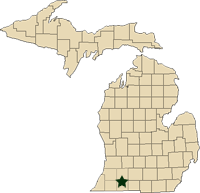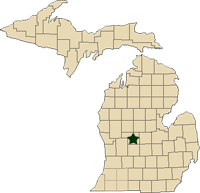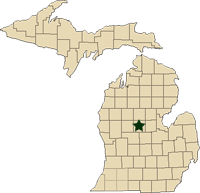Regional reports on Michigan field crops – May 24, 2012
MSU Extension educators’ pest and field crop updates for Michigan.
This week’s regional reports:
- Southwest Michigan – Bruce Mackellar
- West Central Michigan – Fred Springborn
- Central Michigan – Paul Gross
Southwest Michigan – Bruce Mackellar, Michigan State University Extension
|
I am sorry that I will not be able to fill out the complete update as normal, but we are working hard to complete research plots this week.
Corn
Early planted commercial corn is growing rapidly. Advanced fields are at the 4 leaf stage. The majority of the later planted corn is at V1 to V2. Continue to watch for cutworm and armyworm damage in fields that were “green” during late April and early May.
I have seen significant slug feeding injury in a few fields, which is sort of curious, considering how dry it has been over the last couple of weeks. With excellent growing conditions in the forecast, I think most of these fields will outgrow the problem without bait treatment (E-1582 corn section, page 25). Pre-emergence herbicide programs have generally worked well. If you plan to go with a total post-program, watch fields carefully to keep competition from becoming significant.
Also, with warmer temperatures in the forecast, weed height will increase rapidly. Delayed applications of soil applied herbicides in corn (MSU E-434 corn section Table 1G, page 45) by Christy Sprague can provide excellent information on the maximum corn height delayed preemergence programs that can be safely applied to rapidly growing corn plants.
Planting on seed corn fields has been moving forward quickly. I would watch fields carefully for armyworm where cereal cover crops were burned off in late April or early May. Most seed fields are V2 or below. I have observed European corn borer moth activity over several nights when planting research plots this week. Keep an eye out for corn flea beetle damage or treat as per company agronomist recommendations.
Soybeans
Advanced fields are growing well and looking pretty good so far. Many later planted soybeans are just emerging. Watch for bean leaf beetle feeding symptoms. Be sure to watch the weed height carefully in glyphosate-tolerant fields. There are plenty of weeds in some of the more advanced fields, and dry conditions may warrant earlier herbicide applications than normal to reduce competition with the soybean crop.
Watch for Palmer amaranth in fields in St. Joseph and southern Kalamazoo counties. If you find the weed in your fields, we would like to know. You can call the St. Joseph County MSU Extension office at 269-467-5511 and report the field location where you found the weed (all season long).
Wheat
Wheat is advancing rapidly. Wheat has pretty much crossed the flowering stages, so we are just about beyond the fungicide application window for Fusarium head blight. Conditions during flowering were warm and dry for the early part of the period, so risk should have been fairly low across most of the southwest region. Continue to watch fields for signs of armyworm leaf feeding on the upper leaves and clipped heads. We saw elevated moth flight in north central Van Buren County and other locations across Michigan in early May. Scouting is really the only way to determine if armyworms will be a problem in your fields.
Program announcement
MSU Extension is hosting a Wheat Variety Trial Field Day on the evening of June 4 from 6 to 8 p.m. at the research site on Harvey Jipping’s farm, located northwest of Hamilton, Mich. The trial is located between 137th and 140th Avenues on 47th Street (view map).
MSU Extension wheat educator Martin Nagelkirk and MSU wheat breeding program staff members Lee Siler and Randy Laurenz will be on-hand to walk you through the plots. We will also discuss field crop pest management issues.
RUP and CCA credits are pending approval. There is no cost to the program, but we ask that you call the Van Buren County MSU Extension office at 269-657-8213 so that we can plan for refreshments.
A new face in southwest Michigan MSU Extension
I hope that you will join us in welcoming Jon Zirkle to MSU Extension in St. Joseph County. Jon’s first day will be June 4 and he will be joining us at the Wheat Variety Trial Field Day in Hamilton, Mich.
West Central Michigan – Fred Springborn, Michigan State University Extension
|
Weather
Dry weather dominated much of the week as many areas received 1/10 inch or less from Monday’s (May 21) rain. High air temperatures ranged from 70 to near 90°F on Sunday (May 20). Low air temperatures ranged from 33.5°F on Thursday (May 17) to near 60 the following Sunday. Low soil temperatures at 2 inches are in the mid-50s to low 60s. Average relative humidity levels have been in the mid-50s down to low 40s every day this week except Monday. Irrigation systems are running in many wheat fields.
Crops
Wheat is fully headed in many fields. There are still a few fields lagging behind with heads just emerging from the boot. Leaf disease pressure remains fairly low in most fields. Powdery mildew is present low in the canopy in most fields. Susceptible varieties can and do have substantially more powdery mildew. We’ve also seen symptoms of leaf rust. Scout fields this week for armyworm feeding.
Alfalfa continues to be variable in height and quality. First cutting is underway on many farms this week.
Corn planting is virtually complete. Early planted corn is at V2 to V4; the majority of the crop is at V1 to V2 with good stands. As you are scouting fields in west central Michigan this week, watch for black cutworm feeding on emerged corn, especially in no-till fields and fields that had a dense weed cover. While my trap counts were low, many migratory pest populations can vary greatly from one area to the next.
Soybean planting is in its final stages; many of the early planted fields have emerged. Bean leaf beetle feeding has been observed, but does not appear to be threatening the stand.
I caught no armyworm moths this week in pheromone traps in Montcalm County, nor did I catch any black cutworm moths this week. I did, however, capture a few European corn borer moths while scouting a wheat field. European corn borer emergence is ahead of normal this year and its primary host (field corn) is, and will be for a few weeks yet, unattractive for egglaying. There is some potential to see European corn borer damage in other crops such as wheat or oats – this usually does not cause significant injury, but can lead to some head scratching as scouts try to diagnose what burrowed into the stem of the plant and caused it to break off.
Central Michigan – Paul Gross, Michigan State University Extension
|
Weather
Near ideal weather over the past week has allowed farmers to wrap up planting of corn and soybeans by the weekend. Planting conditions have been good for the most part, but some rain will be needed for good emergence on the lighter-textured soils. The unusually warm March has put us about two weeks ahead of normal in growing degree day accumulation if you started counting March 1. However, if you start counting April 1, we are near normal. What this means is the insect populations and perennial weeds are out in greater numbers. Scouting fields early and often is necessary this year to get ahead of any pests that might cause problems.
Commodity reports
The corn crop is planted and emerging quickly with the warm soil temperatures. The crop ranges from just emerging to the 3-4 leaf stage. Sidedress nitrogen applications are being made. Now is a very good time to take pre-sidedress nitrate tests to determine the correct amount of nitrogen needed to meet your yield goal. For optimum nitrogen management on corn, remember the four “c’s”: the correct type, the correct amount, the correct time and in the correct place.
Soybean planting will wrap up this week following a good week of planting progress. Emergence has been good for the most part, but there has been some replanting done on early planted fields. No reported problems at this time. Scout fields for pests. Weeds are doing very well, so get the herbicide applications done in a timely manner to prevent yield loss due to early weed competition.
The wheat crop is the big story in the region. The crop ranges from the boot stage to heading. We are seeing significant disease pressure in some areas. The diseases that have been identified include powdery mildew, Septoria and stripe rust. Fungicide applications are being made for head scab and other leaf diseases. Scout fields for insect pests such as armyworms and cereal leaf beetles.
Alfalfa harvest is well under way. Some farmers will be wrapping up harvest by the weekend while others are just getting started. This year’s crop has been a challenge due to early frost damage in some areas. The frost-damaged fields have made timing of first cut a challenge. There are several reports of alfalfa weevils over threshold in some fields. These fields should be cut as soon as possible and the regrowth monitored for weevil feeding. Yields are being called average to below average.
Oats and barley are progressing very well. Herbicide applications are going on. Scout these fields for foliar diseases.
The sugarbeet crop looks very good with no reported problems.
Planting of dry beans will begin next week.



 Print
Print Email
Email







